Chapter 1. NASA's Facilities Program
1.1. Facility Program Content
1.1.1 The annual facility program is part of the Agency's five-year budget described in
NPD 1000.0, NASA Governance and Strategic Management. The five-year budget includes the Construction of Facilities (CoF) program under the Construction, Environmental Compliance and Restoration (CECR) account for projects of more than $1 million. The CoF program comprises the first four project types:
1.1.1.1 Discrete Projects. Discrete projects have a Facility Project Cost Estimate of
$10 million or more.
1.1.1.2 Minor Revitalization and Construction Projects (MRCs). MRCs have a Facility Project Cost Estimate of more than $1 million but less than $10 million.
1.1.1.3 Demolition Projects. Demolition projects are independent and stand-alone projects to eliminate or reduce real property assets no longer required by NASA.
1.1.1.4 Facility Planning and Design (FP&D) Funds. FP&D funds are used to plan and design facility projects.
1.1.1.5 Other Facility Project Types (Non-CoF Funded). The following alternative methods are currently the only methods authorized for facility projects (e.g., modifying real property) that may cost in excess of $1 million: Energy Savings Performance Contracts (ESPC), Utility Energy Services Contracts (UESC), Enhanced Uses Leases (EUL), and EUL net revenue.
1.2 Facility Program Best Practices
1.2.1 Center Facility Project Managers (FPMs) shall comply with NASA-required best practices regardless of the funding source (e.g., NASA Program, CECR Account, or external funds). Required best practices include the following:
a. Implementing front-end planning as developed by the Construction Industry Institute (CII) using comprehensive planning tools such as the Project Definition Rating Index (PDRI), team building, and other techniques (see CII Best Practices).
b. Investigating the site and providing sufficient preliminary design to develop a full project scope, assess risks, identify construction complexities, and provide a realistic Facility Project Cost Estimate prior to inclusion in the NASA budget submission to the Office of Management and Budget (OMB).
c. Using life-cycle cost vs. first cost to determine the best economic solution (e.g., new construction vs. renovation or adaptive reuse, mechanical and electrical systems, equipment, materials, and methods) (see NASA Business Case Guide for Facilities Projects). Ensure that any large capital energy investment in an existing building employs the most energy efficient and life-cycle cost-effective designs, systems, equipment, and controls.
d. Designing for maintainability to optimize operation and maintenance costs and effort (see CII Best Practices).
e. Commissioning installed equipment, systems, building envelope, and other building elements to ensure quality, operability, reliability, and systems integration.
f. Using environmentally friendly processes, materials, and equipment.
g. Maximizing reuse, recycling, and salvage and minimizing disposal when a project includes demolition (see CII Best Practices).
h. Applying constructability concepts and principles during each phase of the facility project process to ensure the project execution remains practical (see CII Best Practices).
i. Using partnering tools and techniques to establish and maintain professional working relationships among project stakeholders including, but not limited to, users, contractors, and construction managers. See NASA Partnering Desk Reference for more specific guidance.
j. Practicing effective configuration and change order control to minimize project cost and schedule growth.
k. Implementing the safety initiative "Making Zero Incidents a Reality" to encourage proactive safe behavior during the construction phase (see CII Best Practices).
l. Using Design-Build Institute of America's Design-Build Manual of Practice when a design-build approach is planned.
1.3 Sustainability Requirements
1.3.1 For all CoF level projects, Center FPMs shall comply with the five guiding principles described for Federal High Performance and Sustainable Buildings (FHPSB) in Exec. Order 13514, Federal Leadership in Environmental, Energy, and Economic Performance and Exec. Order 13423, Strengthening Federal Environmental, Energy, and Transportation Management.
1.3.2 For New Construction and Major Renovation, in addition to complying with the five guiding principles referenced in section 1.3.1, CoF FPMs shall ensure all projects are designed to meet a minimum level of Leadership in Energy and Environmental Design (LEED) Silver certification using United States Green Building Council (USGBC) criteria.
1.3.3 Variances to This Policy. If the FPM does not think compliance with the minimum LEED requirements is reasonable for a particular project, the FPM shall submit a letter requesting a waiver from the minimum LEED requirements explaining why compliance is imprudent along with a completed initial LEED checklist to the NASA Headquarters Office of Strategic Infrastructure. Compliance with the five guiding principles in accordance with the previously referenced Exec. Orders is mandatory.
1.4 CoF Program Formulation
1.4.1 The CoF project life cycle shown in Figure 1-1a (from NPR 7120.7) comprises the formulation phases of project planning/development and design and the implementation phases of construction, activation, operations and maintenance, and decommissioning. The figure shows the full life cycle and this NPR addresses all phases except Operations, Phase E. NASA Centers and Headquarters formulate the CoF program through a collaborative process that spans four consecutive phases: concept presentations are for out-year projects, prioritization of construction, design funding, and construction funding. The following paragraphs describe this process.

Figure 1-1a CoF Project Life Cycle
1.4.2 Guidance. Each year, NASA's Office of the Chief Financial Officer (OCFO) issues guidance to the Centers for reporting their budget requests. The OCFO coordinates this through the Mission Directorates and Mission Support Offices.
1.4.3 Establishing Project Scope. The scope of a project defines the extent of the proposed work, project goals, and justification. The FPM shall establish the project scope in cooperation with Center management and other project stakeholders.
1.4.4 Fragmentation. FPMs shall ensure all CoF projects are complete and usable within the proposed scope of the project. Splitting project into parts with the intent of circumventing the CoF approval process is an example of fragmenting a project. NASA Centers do not have authority to fragment facility projects. In establishing a project scope, a NASA Center includes all of the necessary elements in a single project to avoid fragmentation or the appearance of fragmentation. (See Appendix A, Definitions for clarification of "fragmentation," "facility project," and "full disclosure concept.")
1.4.5 Incremental Programming for Facility Requirements. Incremental programming for facility requirements is a process of planning and executing CoF funding over more than one fiscal year for a specific purpose. Incremental programming differs from fragmentation in that it fully discloses the overall plan. NASA has no authority to formulate or execute CoF projects using incremental programming and shall not do so without special legislation.
1.4.6 Phased Projects. Phasing involves repairing or replacing a facility in segments. NASA is authorized to accomplish work in phases. A completed phase will be usable (e.g., a useful segment that stands alone and independent of subsequent phases). On the NASA Form 1509, the FPM shall include a statement that explains the scope of the particular phase, how many phases are planned, and the associated estimated total cost of all phases.
1.4.7 Budget Request (Five-Year Plan). Center CoF Program Managers shall develop and submit a budget request (five-year plan) in accordance with the annual guidance issued through the NASA OCFO (see NPR 9420,1, Budget Formulation). See Figure 1-1b CoF Five-Year Plan for an overview and Figure 1-1c Institutional CoF Call and Programming Phase of Planning, Programming, Budgeting, and Execution System (PPBES) for a more detailed delineation of the three years from prioritization through construction. FED issues data calls (one for institutional and one for program direct) to the Centers and Mission Directorates in support of the OCFO budget guidance. Centers provide the required data to facilitate prioritization of the CoF program Agency-wide.
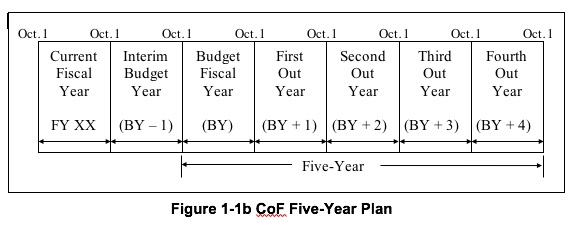
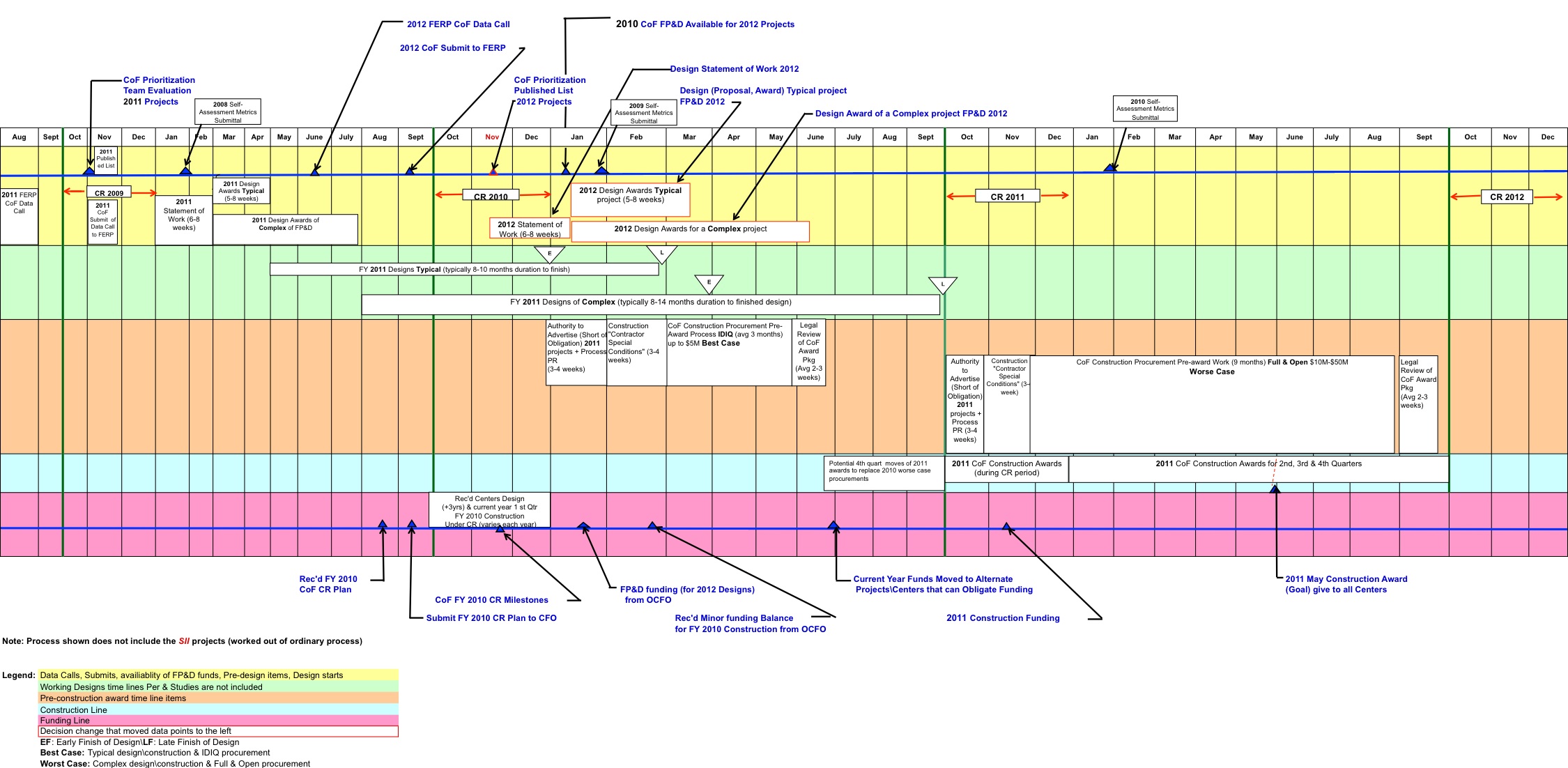
Figure 1-1c Institutional CoF Call and Programming Phase of Planning,
Programming, Budgeting, and Execution System
1.4.8 Documentation. The CoF program manager shall prepare the following documentation for each CoF project:
a. A NASA Form 1509, Facility Project-Brief Project Document.
b. A NASA Form 1510, Facility Project Cost Estimate.
c. A Life-Cycle Cost Analysis (LCCA). LCCAs for discrete CoF projects are submitted during the data call, along with the draft budget narrative (see NASA Business Case Guide for Facilities Projects). LCCAs for all other CoF projects should be kept in the project folder and made available on request by FED.
d. A Risk Assessment. Risk assessment format and content will comply with the template provided in FED's annual data call.
1.4.9 Headquarters Review and Prioritization. The FED leads the review and prioritization of institutional facility projects proposed for NASA's five-year plan based upon documentation provided by the Centers. This review includes an evaluation of existing capabilities to minimize or eliminate the creation of excess capacity within NASA or the private sector, e.g., construction of a ground-based test facility at a particular Center when there is adequate availability and capability to accomplish the same requirements at a different Center or in the private sector. For facility projects funded from other sources (e.g., program-direct or external funds), the FED and the associated Mission Directorate coordinate the process.
1.4.10 CoF Program Approvals. Figure 1-2 depicts the CoF program approval process. The CoF program is part of the annual appropriation request NASA submits to OMB.
1.4.11 Public Release. Until released by the appropriate committees of Congress, no project stakeholder (e.g. FPM, Architectural-Engineering (A-E) firm, NASA employee) shall publicly disclose CoF project information (including subprojects and/or work packages). A-E contracts will include a statement governing public release of project specifics.
1.4.12 NASA Headquarters. Based on the five-year plans submitted by the Centers, NASA Headquarters prepares and submits the draft appropriation request to OMB. This submittal is coordinated with the OCFO, Mission Directorates, Mission Support Offices, and Center Management. The NASA Administrator, through the OCFO, is responsible for NASA's appropriation request.
1.4.13 OMB Review. OMB reviews NASA's five-year plan and responds with changes, comments, and questions via a "passback." After NASA answers the passback, OMB provides a "markup" for use in preparing NASA's final submission. Using the OMB budget markup, NASA prepares and submits a final budget appropriation request to OMB. Following final approval, OMB incorporates NASA's planned budget into the President's budget for submission to Congress.
1.4.14 Facility Project Authorization and Appropriations. Using the President's budget as a starting point, committees in the Senate and House of Representatives develop the authorization and/or appropriation bills. The Congress approves and sends the bill(s) to the President for review and action. The bill becomes public law (or act) once the President has approved it.
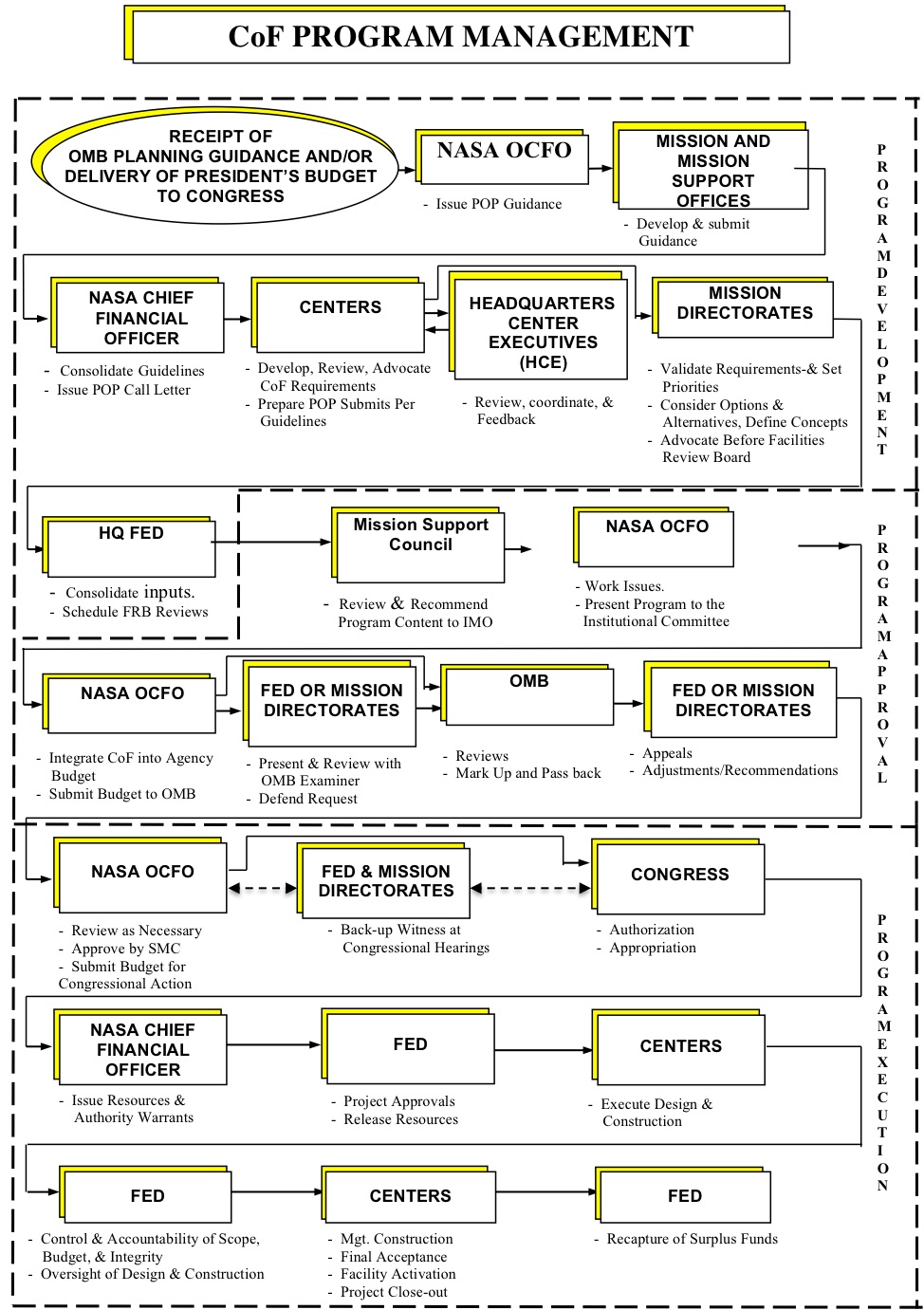
Figure 1-2 CoF Program Management
1.4.15 Program Oversight. As the CoF program proceeds through the authorization and appropriation process, NASA Headquarters (OCFO, FED, Mission Directorates, and Mission Support Offices) inform the Centers concerning the status of proposed facility projects.
1.4.16 Process for Handling Dissenting Opinions. Programs and projects shall follow the Dissenting Opinion Process per NPD 1000.0, NASA Governance and Strategic Management Handbook.
1.4.17 Program Execution. Execution is the process of obligating and managing contracts to accomplish project objectives. To "obligate" funds on a project means to award a contract (including ESPC and UESC) or purchase order. The FED goal is to obligate all CoF projects approved for design and construction by the end of the fiscal year. Early obligation of CoF projects is encouraged, and late obligation could place a project at risk of losing project funding (see Appendix A, Definitions, "at-risk project"3 ). The following paragraphs describe facility program execution, and Figure 1-2 depicts this process.
3 Funding allocation may be lost when a project is at risk. The resources allocated to an at-risk project can then be made available to satisfy shortages in Congressional appropriations or fund projects at locations where resources can be obligated in a timely manner.
1.4.18 Financial Resources for Facility Projects. The annual appropriations acts contain the principal funding authorities for CoF projects. This funding supports preliminary engineering, design, and construction of those projects. Identifying, planning, and developing the requirement into a proposed project and its activation after construction are paid for using non-CoF funds (see Figure 1-3a, Facilities Project Activities and Funding for Design-Bid-Build and Figure 1-3b, Facilities Project Activities and Funding for Design-Build). In some instances, another Federal agency, State or local government, or other party acquires funding for facility work at a Center through Agency agreements, the private sector as specified in contracts, or a nonappropriated fund activity such as a NASA Exchange. Regardless of the source of funds, approval authority shall comply with NPD 7330.1, Approval Authorities for Facility Projects.
Note 1: Non-CoF-funded studies evaluate current systems, facilities, and capabilities. These studies are done prior to or during project development. The decision to proceed with a CoF-project may be the product of this study, but it is not the primary reason for the study. CoF-funded studies are for site investigations to verify as-builts and/or existing utilities, as well as site conditions; e.g., soil borings. These studies are done once a project scope and preliminary Facility Project Cost Estimate have been developed. These studies are typically done as predesign.
Note 2: CoF-funded activation includes installed IT/communication infrastructure up to signal outlets; required demountable partitions and installed systems furniture; and any installed building support specialty equipment such as required emergency warning systems, installed security systems, and installed specialized material or file handling/storage equipment necessary for the facility to function for its intended use. Non-CoF-funded activation includes any other items necessary for the occupancy of the facility.
Note 3: Mixing funds between CoF, Center-directed, power purchase agreements (PPA), ESPC, and UESC is not authorized; however, there may be selected instances where it would be acceptable to combine efforts within a new construction or major renovation project; e.g., using a PPA to add photovoltaic panels to augment the power to the new facility. HQ FED reserves the right to approve or reject any such expenditure when coupled to a CoF project. The CoF project will, in all instances, be a stand-alone project providing a complete and usable end product.
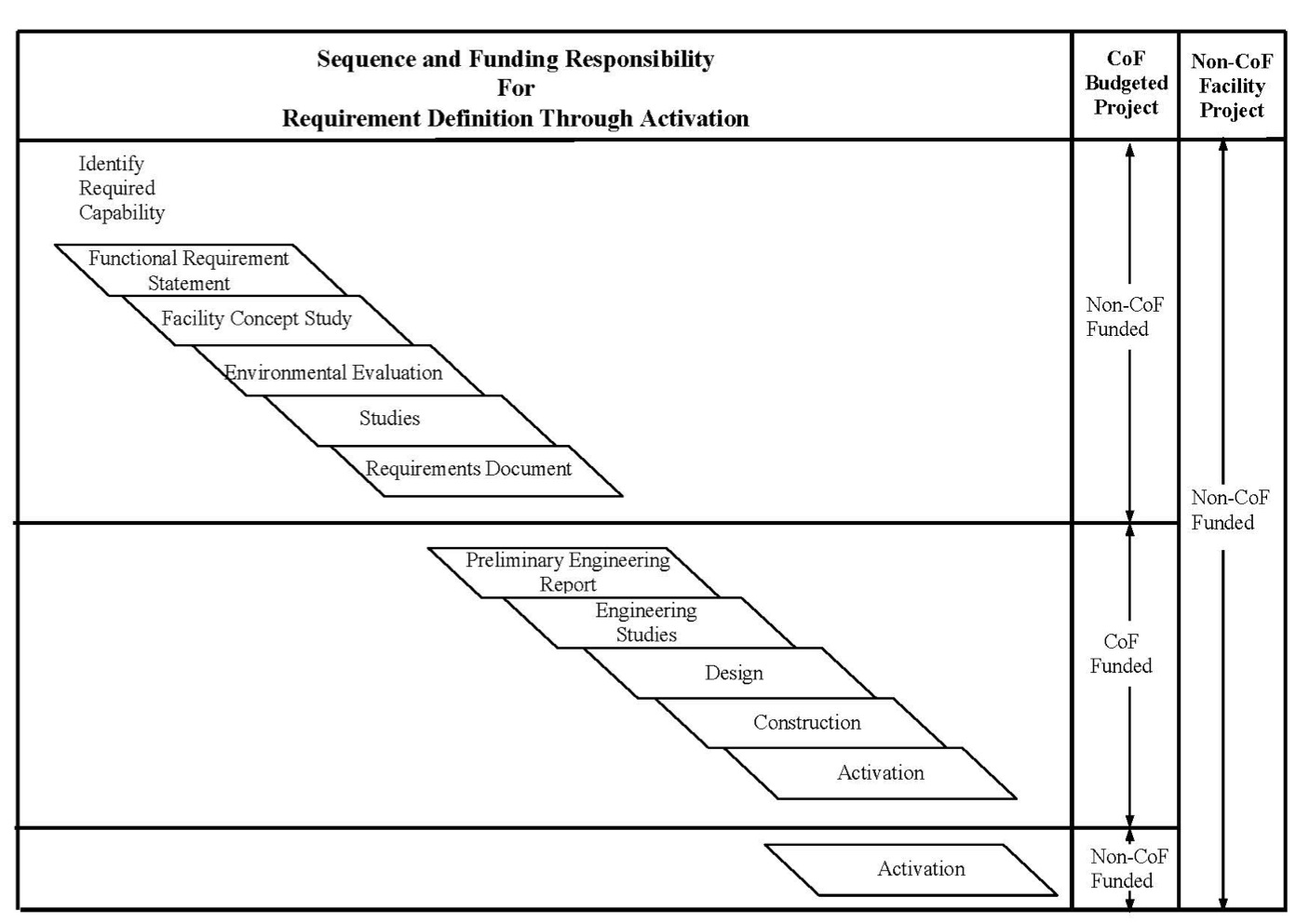
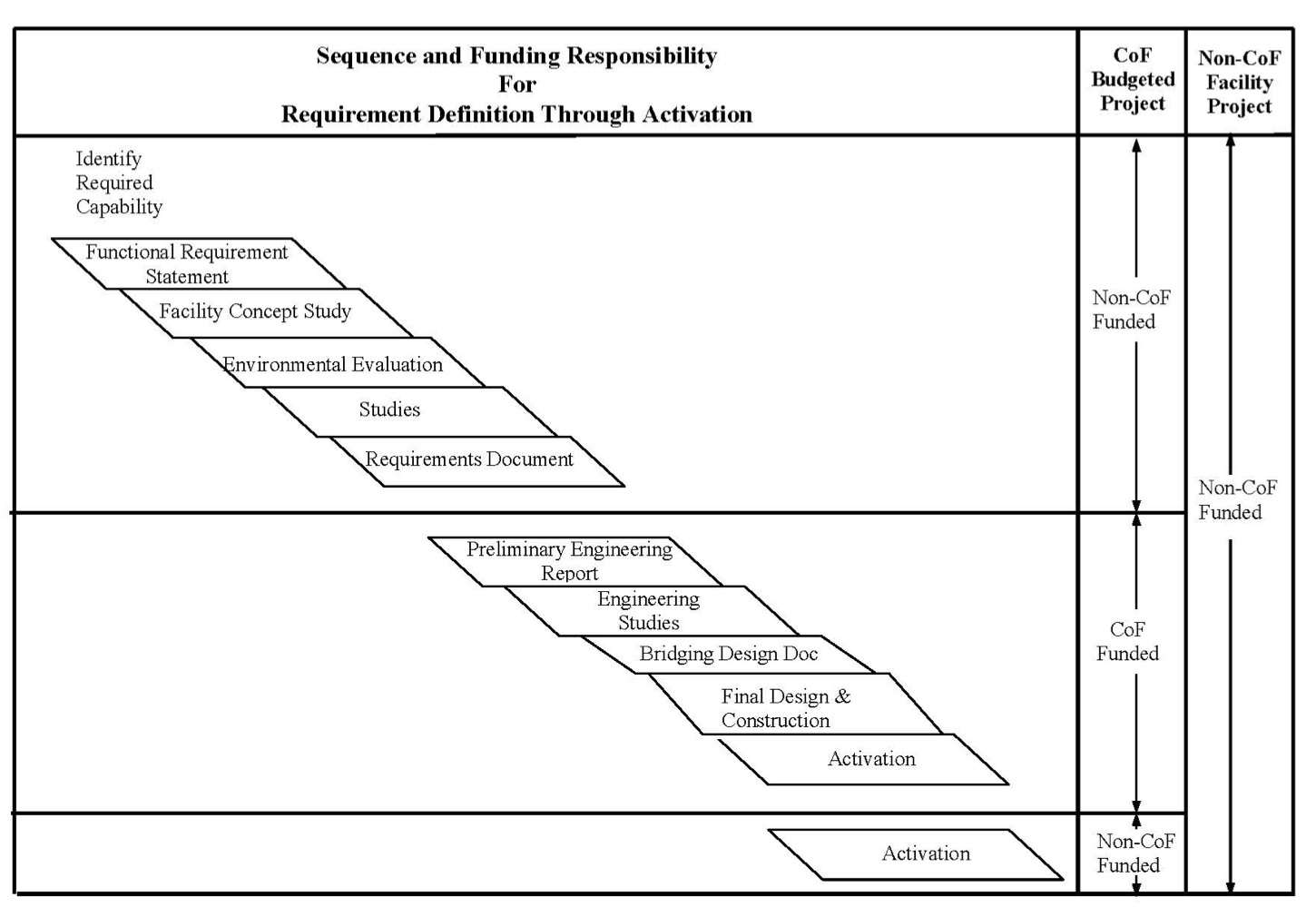
1.4.19 Facility Project Fiscal Management
1.4.19.1 CoF Thresholds. See section 1.1 for current CoF fund types and associated thresholds. The annual appropriation legislation is the only accepted source for adjustments to CoF thresholds.
1.4.19.2 Project Approval. The authorities and responsibilities identified in NPD 7330.1, Approval Authorities for Facility Projects, apply to all facilities projects, regardless of fund source. At a minimum, project concurrence and approval shall include the Center representative with delegated responsibility for construction, validation of requirements by support program or organization and the funding organization. Each facility project with a Facility Project Cost Estimate of $100,000 or more will have an approved NASA Form 1509, Facility Project-Brief Project Document, and NASA Form 1510, Facility Project Cost Estimate, prior to obligating funds on that project. The FPM prepares these. Approval requirements vary according to the types of funds expended as follows:
a. Center-Approved and -Funded Projects. Center-approved and -funded projects have a Facility Project Cost Estimate of $1 million or less. Centers approve and fund these projects; however, FED reviews NASA Forms 1509 for projects with a Facility Project Cost Estimate of $100,000 or more to ensure compliance with NASA policy, to prevent the appearance of fragmentation, and to ensure a complete record in the NASA Real Property Management System (RPMS). Center CoF Program Managers shall submit approved 1509s in excess of $100,000 to FED for review prior to obligating funds.
b. Facility Planning and Design Funds (FP&D). Based on the results of the prioritization process, FED authorizes projects for design and provides funds to accomplish facility planning and design of CoF projects. Center CoF Program Managers shall request funds and approval via the Space Act Agreement Maker (SAAM) and attach a NASA Form 1509 in the SAAM. FED replies with authority to design using the NHQ DIV799PD, Facility Planning and Design - Planning and Design form transmitted either through SAAM or by e-mail.
c. MRC Projects and Discrete Projects. Centers request the authority to advertise for construction and approval for construction by submitting a signed version of NASA Form 1509 and the CoF Routine Transaction Form to the FED via SAAM. After FED reviews the project documentation and the proposed project complies with current budget authority, it approves the project and the expenditure of discrete or minor funds by concurring in the SAAM. For CoF projects, FED includes stipulations for expenditures on NASA Form DIV80002, the Minor Facility Projects Summary Brief Project Document, at the time of issue.
d. Externally Funded Facilities Projects. Funding approval and authority comes from the party providing funds; however, NASA facility project approval requirements shall comply with NPD 7330.1, Approval Authorities for Facility Projects. Centers will request approval by submitting NASA Form 1509 and NASA Form 1510 to the Director, FED for review and approval.
e. Energy Savings Performance Contracts (ESPC) and Utility Energy Services Contracts (UESC). For projects where the estimated investment value in any individual facility is less than $1 million, follow section 1.4.16.2.a Center-Approved and Funded Projects. For all other projects, Centers request facility project approval by submitting NASA Forms 1509 and 1510 to FED via the SAAM E-Router; FED reviews and approves the facility project by approving the E-Router.
f. Enhanced Use Leases (EUL). For EUL agreements that include a facility project, follow section 1.4.16.2.d Externally-Funded Facilities Projects and NASA Desk Guide for Enhanced Use Leasing of Real Property.
g. EUL Net Revenue At or Above $100,000. Centers request approval to implement a facility project using EUL net revenue with an estimated cost of greater than or equal to $100,000 by submitting NASA Forms 1509 and 1510 along with the EUL Routine Transaction Form to FED via the SAAM E-Router. FED reviews and approves the facility project and the expenditure of EUL net revenue by approving the E-Router including a NHQ DIV799EUL Enhanced Use Lease Project Approval Form generated at HQ.
h. EUL Net Revenue Below $100,000. Centers request approval to implement a facility project using EUL net revenue with an estimated cost of less than $100,000 by submitting a EUL Routine Transaction Form to FED via e-mail. FED reviews and approves the facility project and the expenditure of EUL net revenue by approving that form and with a NHQ DIV799EUL Enhanced Use Lease Project Approval Form generated at HQ.
1.4.19.3 Requesting Construction Funds. Center CoF Program Managers shall request construction funds using the SAAM with the CoF Routine Transaction Form and NASA Form 1509 attached for each project.
1.4.19.4 Receipt of Funds. After project approval is complete and upon receipt of the work breakdown structures (WBSs) from Centers for approved design and construction projects, FED transmits funding to the Centers electronically through NASA's financial system. Center Contract Officers shall award CoF contracts only upon receiving approval authority and funds.
1.4.19.5 Authority to Advertise. FED grants authority to advertise for design and /or construction when it approves (via SAAM) NASA Form 1509. However, FED may grant advanced authority to advertise if necessary and appropriate.
1.4.19.6 Procurement. When professional services such as a design by an A-E firm or a construction contractor are identified, the contract acquisition shall comply with the FAR and NASA FAR supplement. FPMs will collaborate with Contracting Officers to comply diligently with the goals set forth in section 1.4.17, Program Execution.
1.4.19.7 Program Reporting Requirements. Center CoF Program Managers shall maintain records for each CoF project and submit Quarterly Reports, Functional Performance Metrics, and Sustainability Progress Reports to Headquarters.
1.4.19.8 Quarterly Report. Unless the Headquarters program manager has access to current project status via a Center electronic project management system, the Center CoF Program Manager provides the Headquarters program manager with quarterly project updates that include the following at a minimum:
a. Program-related requirements such as capability, schedule, and cost.
b. Design milestones for 30 percent and 90 percent including estimated and actual start dates, review dates, and completion dates.
c. Construction milestones including estimated and actual start dates, work packages, phases, commissioning, activation, beneficial occupancy, and closeout.
d. Funds management for design and construction including the budget amount requested during the budget formulation phase, the Current Cost Estimate (CCE), funds received, funds committed, and funds obligated.
e. Outstanding issues such as significant change orders, safety concerns, or cost overruns and the plans to mitigate these actions.
1.4.19.9 Functional Performance Metrics. The Center CoF Program Managers shall provide functional performance metrics to the FED in response to the FED's annual call for functional performance metrics. These metrics include the CoF Self-Assessment Metrics and the Quality Survey (included as a tab within the CoF Self-Assessment Metrics file). The date for the submission to the FED is included in the call letter but typically would be January 31 after the fiscal year (FY) being assessed.
1.4.19.10 Sustainability Progress Reports. NASA Center Program Managers shall submit an annual report of their progress toward implementing sustainability goals. FED requests and transmits reporting requirements annually, but the following represent typical minimum requirements:
a. Total number of new design projects initiated during the fiscal year.
b. Total number of new designs eligible for LEED registration.
c. Number of new design projects registered for LEED certification and at what level, i.e., Certified, Silver, Gold, or Platinum.
d. Number of completed construction projects eligible for LEED certification and number of completed construction projects achieving LEED certification and at what level, i.e., Certified, Silver, Gold, or Platinum.
DISTRIBUTION:
NODIS
This Document is Obsolete and Is No Longer Used.
Check the NODIS Library to access the current version:
http://nodis3.gsfc.nasa.gov
![[NASA Logo]](../Images/nasaball.gif)





